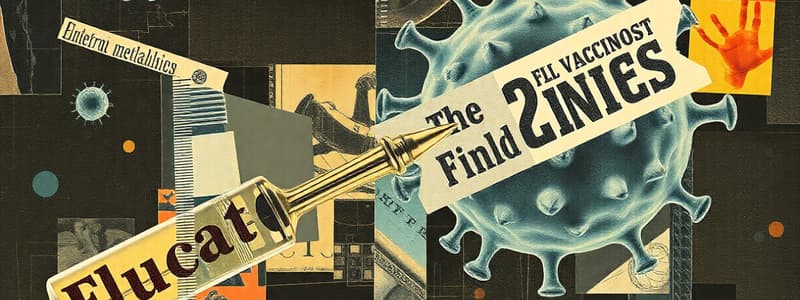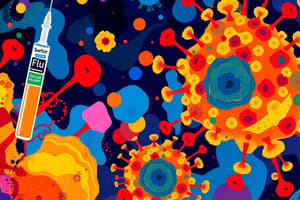Podcast
Questions and Answers
In which organelle does aerobic respiration predominantly occur in eukaryotic cells?
In which organelle does aerobic respiration predominantly occur in eukaryotic cells?
- Nucleus
- Chloroplast
- Mitochondrion (correct)
- Golgi apparatus
What is the primary function of oxygen in aerobic respiration?
What is the primary function of oxygen in aerobic respiration?
- To act as the final electron acceptor in the electron transport chain (correct)
- To enhance the breakdown of fatty acids
- To facilitate the synthesis of glucose
- To increase ATP yield from anaerobic processes
During which phase of the bacterial growth curve does the population size remain constant?
During which phase of the bacterial growth curve does the population size remain constant?
- Stationary phase (correct)
- Decline phase
- Lag phase
- Log phase
Which type of transport across a cell membrane requires no energy from the cell?
Which type of transport across a cell membrane requires no energy from the cell?
How does the flu shot enhance the body's ability to fend off influenza?
How does the flu shot enhance the body's ability to fend off influenza?
What is the main function of ATP in cells?
What is the main function of ATP in cells?
Which phase of bacterial growth is marked by a balance between cell division and cell death?
Which phase of bacterial growth is marked by a balance between cell division and cell death?
What is fermentation's main purpose in cells?
What is fermentation's main purpose in cells?
What type of virus is present in the nasal spray flu vaccine?
What type of virus is present in the nasal spray flu vaccine?
Which phase of bacterial growth has no cell division occurring?
Which phase of bacterial growth has no cell division occurring?
Which of the following is primarily responsible for transporting electrons during respiration?
Which of the following is primarily responsible for transporting electrons during respiration?
Which process does NOT produce ATP during aerobic respiration?
Which process does NOT produce ATP during aerobic respiration?
Which flu vaccine option is best for people with egg allergies?
Which flu vaccine option is best for people with egg allergies?
What describes the nature of facilitated diffusion?
What describes the nature of facilitated diffusion?
What happens when a cell is in a hypertonic solution?
What happens when a cell is in a hypertonic solution?
How are flu vaccines typically produced?
How are flu vaccines typically produced?
What is the relationship between herd immunity and vaccination?
What is the relationship between herd immunity and vaccination?
Which nutrient is classified as a macronutrient that cells require?
Which nutrient is classified as a macronutrient that cells require?
Which process moves particles from high to low concentration without energy?
Which process moves particles from high to low concentration without energy?
When does the death phase in bacterial growth occur?
When does the death phase in bacterial growth occur?
What is the function of an enzyme's active site?
What is the function of an enzyme's active site?
What do flu vaccines typically contain to prepare the body for influenza?
What do flu vaccines typically contain to prepare the body for influenza?
Which structure primarily facilitates the movement of water across cell membranes?
Which structure primarily facilitates the movement of water across cell membranes?
Anabolism is best defined as which of the following processes?
Anabolism is best defined as which of the following processes?
Which organelle is primarily responsible for the production of ATP in eukaryotic cells?
Which organelle is primarily responsible for the production of ATP in eukaryotic cells?
What is the egg-free flu vaccine primarily made from?
What is the egg-free flu vaccine primarily made from?
During which bacterial growth phase do the bacteria die off faster than they reproduce?
During which bacterial growth phase do the bacteria die off faster than they reproduce?
Binary fission is primarily known as what type of process?
Binary fission is primarily known as what type of process?
Which term describes the type of respiration that occurs without the presence of oxygen?
Which term describes the type of respiration that occurs without the presence of oxygen?
Study Notes
Flu Vaccines
- Flu vaccines train the immune system to recognize and fight the flu virus.
- They contain either inactivated (killed) or weakened live flu viruses.
- The nasal spray vaccine uses a weakened live virus.
- Egg-free vaccines use proteins from the flu virus, not the virus grown in eggs.
- Flu vaccines are recommended for most people aged 6 months and older.
- It takes about two weeks for the vaccine to become fully effective.
- Flu vaccines are updated yearly to address new strains of the virus.
Cell Metabolism & Transport
- Macronutrients are essential for cell function; oxygen is an example.
- Micronutrients are also vital; zinc is an example.
- ATP is the cell's primary energy currency.
- Enzymes speed up chemical reactions within cells.
- Active transport requires energy to move molecules against their concentration gradient (low to high).
- Passive transport (simple and facilitated diffusion, osmosis) does not require energy. Facilitated diffusion uses protein channels. Osmosis is water movement across a membrane to equalize solute concentration.
- Anabolism builds larger molecules from smaller ones; catabolism breaks them down.
- Mitochondria generate ATP, the "powerhouse" of the cell.
Microbiology
- Bacteria reproduce through binary fission.
- Aerobic respiration uses oxygen to produce ATP; anaerobic respiration doesn't.
- Fermentation produces lactic acid (e.g., in muscles) when oxygen is scarce, yielding less ATP than aerobic respiration.
- Bacterial growth phases: lag (no division), log (rapid division), stationary (equal birth and death rates), death (death exceeds birth).
- Herd immunity protects the unvaccinated when a substantial portion of the population is vaccinated.
Additional Points
- Hypertonic solutions cause cells to shrink (water loss).
- The final electron acceptor in aerobic respiration is oxygen. In anaerobic respiration, it can be nitrate, sulfate, or carbonate.
- Glycolysis breaks down glucose into pyruvate, a preliminary step in both aerobic and anaerobic respiration.
- Antibodies are produced by the immune system to fight infections. Vaccines induce antibody production.
Studying That Suits You
Use AI to generate personalized quizzes and flashcards to suit your learning preferences.
Related Documents
Description
Test your knowledge on flu vaccines and cellular metabolism with this comprehensive quiz. Learn about the functioning of vaccines, the importance of macronutrients and micronutrients, and the mechanisms of transport in cells. Perfect for students studying biology and health sciences.




